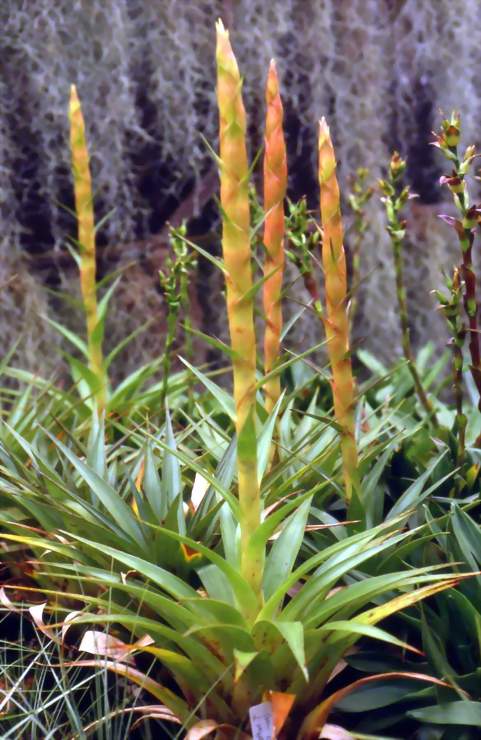
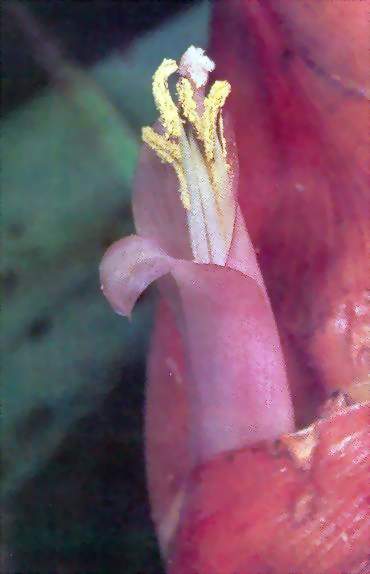
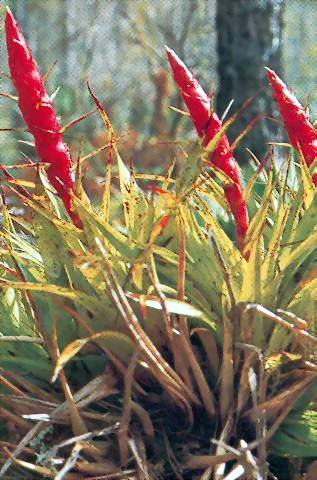
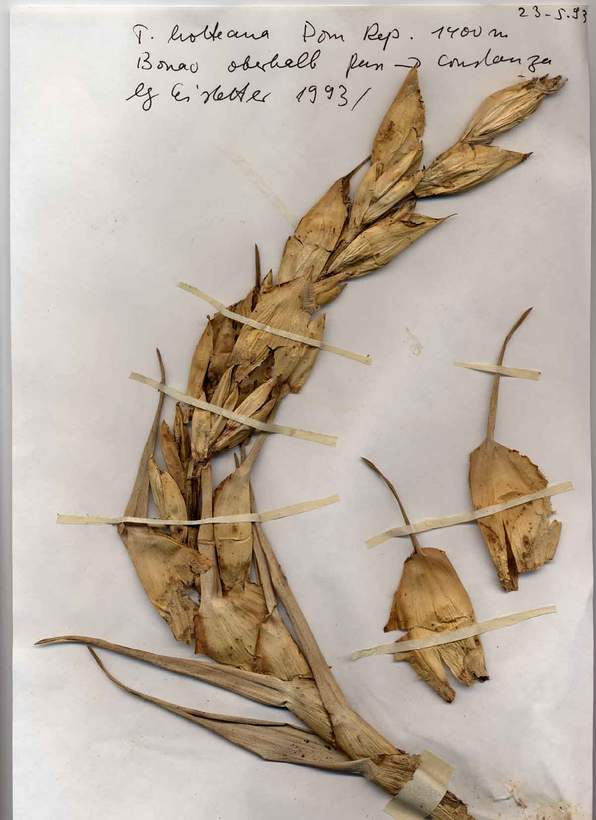
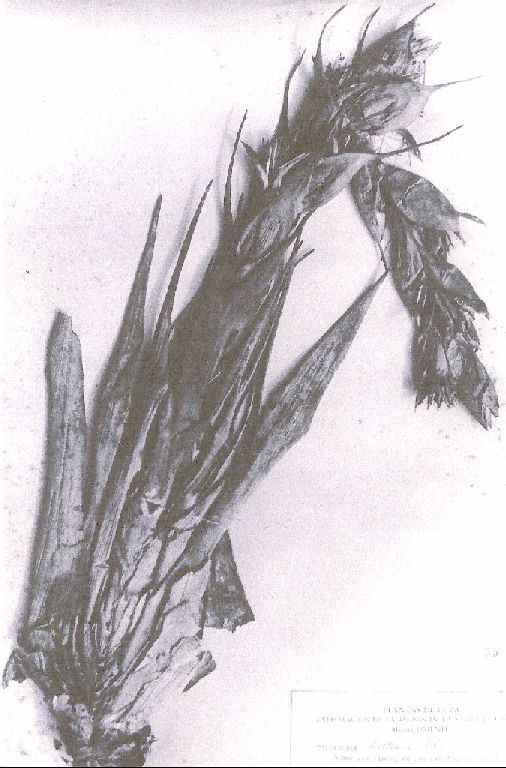
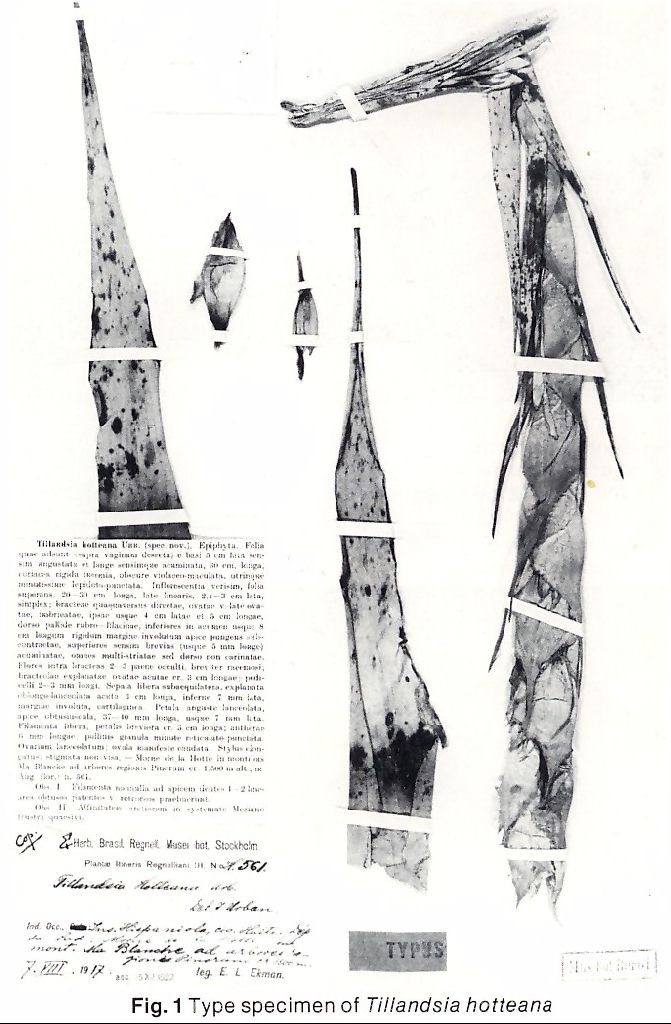
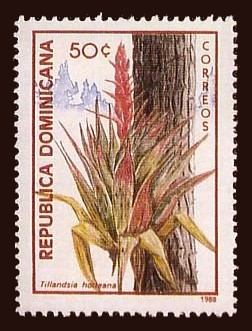
Tillandsia hotteana Urban. Ark. Bot. 17(7): 16. 1921.
Desc from S&D p781
Plant stemless, flowering to 65 cm high.
Leaves many in a dense infundibuliform rosette, 35 cm long;
Sheaths broadly elliptic, nearly as long as the blades, densely brown- punctulate, the upper half deep-purple, the lower pale ferrugineous;
Blades narrowly triangular-attenuate with the extreme apex subulate-involute, 4 cm wide, pale green with large irregular purple spots, obscurely punctulate below, subglabrous above.
Scape erect, stout;
Scape-bracts erect, foliaceous, densely imbricate.
Inflorescence compound, very densely cylindric or subfusiform 2-3 dm long, 3-5 cm in diameter;
Primary bracts erect, densely imbricate, suborbicular, 5 cm long exclusive of the blades and exceeding the axillary spikes, subinflated, even or faintly striate, pale reddish-violet, (brilliant red – Rauh) the lower ones with strict foliaceous blades to 8 cm long, the upper merely apiculate;
Spikes sessile, broadly ovate, complanate, densely 2-6-flowered.
Floral bracts broadly elliptic, acute, to 3 cm long. equaling the sepals, ecarinate, subcoriaceous, even, glabrous outside, finely punctulate-lepidote inside;
Flowers erect; pedicels 2-3 mm long.
Sepals linear-lanceolate, acute, coriaceous, even, glabrous outside, connate posteriorly; Petals linear-lanceolate, obtuse, 4 cm long, 7 mm wide;
Stamens included.(exserted – Rauh)
Type. Ekman 561 (holotype B; isotype S, GH photo), Morne La Hotte, Ma Blanche Range, Du Sud, Haiti, .7 Aug 1917. . .
DISTRIBUTION. Epiphytic in forest, 1050-2000 m alt, Cuba, Hispaniola.
CUBA. ORIENTE: Jul 1922, Turquino, Sierra Maestre, Leon 11061 (LS, NY); Ekman 14495 (S); 19 May 1948, Acuna 15066 (SV); Mayari, Sierra de Cristal, Apr 1956, Alain, Acuna & Figueiras 5704 (LS). HAITI. Morne de Wegan, Furcy, 1920, Leonard 4800 (US); Massif de Selle Petionville, 15 Aug 1924, Ekman H-1494 (S, US); Morne Basil, L' Artibonite, 15 Nov 1924, Ekman H-2536 (S); Morne Baron, Massif du Nord, St. Louis du Nord, 19 Aug 1925, Ekman H-4682 (S); Morne La Selle, 3 Aug 1944, Holdridge 1914 (US). REPUBLICA DOMINICANA. Monte Gallo, Moncion, Santiago, 19 Jun 1929, Ekman H-12907 (S); Montiada Nueva, Polo, Barahona, Aug 1946, Howard 8592 (GH, US); Diego de Ocampo Peak, 3 Sep 1961, Jimenez 4561 (US); Monteada Nueva, Cana Brava, Barahona Mountains, 15 Jun 1968, Liogier 11645 (NY, US); Lorna de la Sal, Jarabacoa, Oct 1968, Liogier 13395 (NY, US).
Tillandsia hotteana var. citrina Rauh & Ariza Julia, J. Bromeliad Soc. 33:112. 1983, nom. nud. No Latin or type cited
Differs from Type in :
Primary bracts bright, lemon-yellow, with green blades or tips -V- Primary bracts bright-red;
plants growing mostly singly -V- plants mostly forming dense clusters
"The most important discovery in the region of Jarabacoa was a yellow form of the rare Tillandsia hotteana, which is distributed only in Cuba and Hispaniola. This very attractive species with its densely cylindric inflorescence resembles somewhat Tillandsia imperialis, but the inflorescences are much longer; up to 50 cm long and 5 cm in diameter. We are of the opinion that we discovered a new variety of T. hotteana, which we call T. hotteana var. citrina Rauh et Ariza Julia (Coll. Nr. 58 552). It differs from the type (Ekman 561, Herb. Berlin,) by the bright, lemon-yellow, green tipped primary bracts while the type has brilliant red primary bracts ,with long green blades. In conflict with the original diagnosis of Urban (Botan. Archiv. Vol. 17,1921), the stamens were not included, but exserted a little. Unfortunately, nothing can be said about the flower color of this yellow bracted variety because all plants were already in fruit. The 3-angled capsules are green and exsert the primary bracts. Further collecting in the region between Jarabacoa and El Rio must be made in order to determine the extent of distribution of the yellow-bracted variety."
From Moscosa 4: 54-104. 1986 Zanoni. Mejia, and Read
Translated by Butcher-
Plant epiphytic in high areas. Leaves clear green, spotted with red or red-purple.
Scape and inflorescence erect. Primary bracts of the inflated inflorcscence red or dark red, with green apexes.
Corolla blue to blue-violet.
Inflorescence usually red during flowering; when fruits develop, the primary bracts lose their red colour changing to cream. Then the colour of the inflorescence can be red or yellowish with red or yellowish stains. When the fruit mature, the dry inflorescence has a khaki colour or a clear toast. Rauh (1983) described the plants with the yellow inflorescence as Tillandsia hotteana var. citrina Rauh & Ariza Julia. In our field work, we have never found the yellow inflorescences in plants in a flowering state, only after flowering. For this reason, it is not necessary to designate a special name for a taxon being based on these characteristics.
Distribution: H: MN, MS, MH. RD: CS, DC, SB. In the humid pinegroves, mixed forests, or wide leaved forests of the high areas of the mountain ranges, from 800 - 1900 m.
In the pinegroves, it grows with Tillandsia compacta. (Fig. 5).
Notes:
email from Timm Stolten, Heidelberg BG, 11/11/07
Hi Derek, Hi Eric,
if you guys are good in reading hieroglyphics, I would love to send you a copy of Rauh's notes.
He must have written it during an off-road drive or after 4 cans of beer. Terrible.........
Anyway, Tillandsia hotteana var. citrina does only exist in his notes.
We do neither have a live plant nor any kind of herbarium or in-spiritu-material.
The number and the taxon do not exist in our database, so I guess that the plants did not get here alive or died shortly after arrival.
Sorry, but this is all I have found out.
Greetings Timm from Heidelberg
email from Harry Luther 12/11/07
To: "derek butcher"
Dear Derek et al; I never paid any attention to this as I assume it represented a postfloral example. T. hotteana fades to yellowish.
HEL